|
Effect
Inhibits activity of airborne,
adhered bacteria1-3 & viruses4-6
Certain bacteria and viruses are far too small to see
The difference in size between a certain bacteria and viruses is about the same as the difference between apples and sesame seeds.
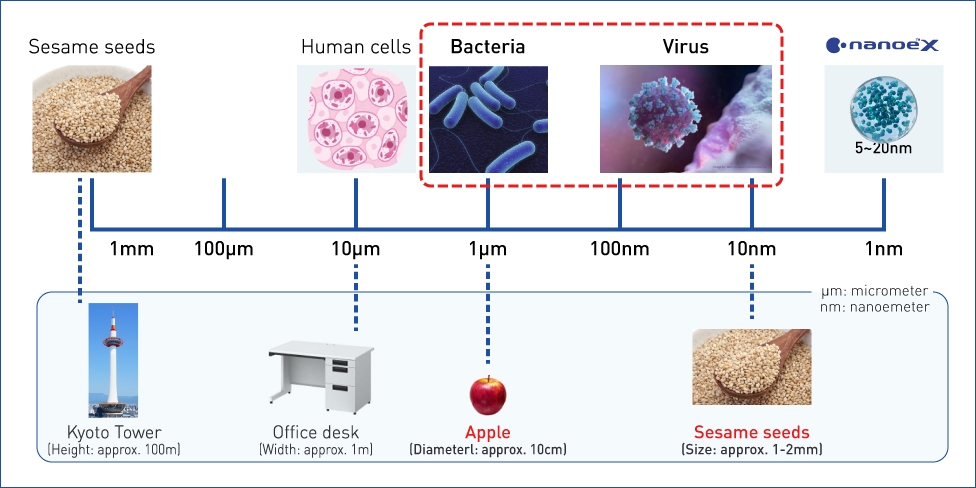
The virus survives different periods on different surfaces
Survival period varies depending on surface, from 3 hours to 7 days.
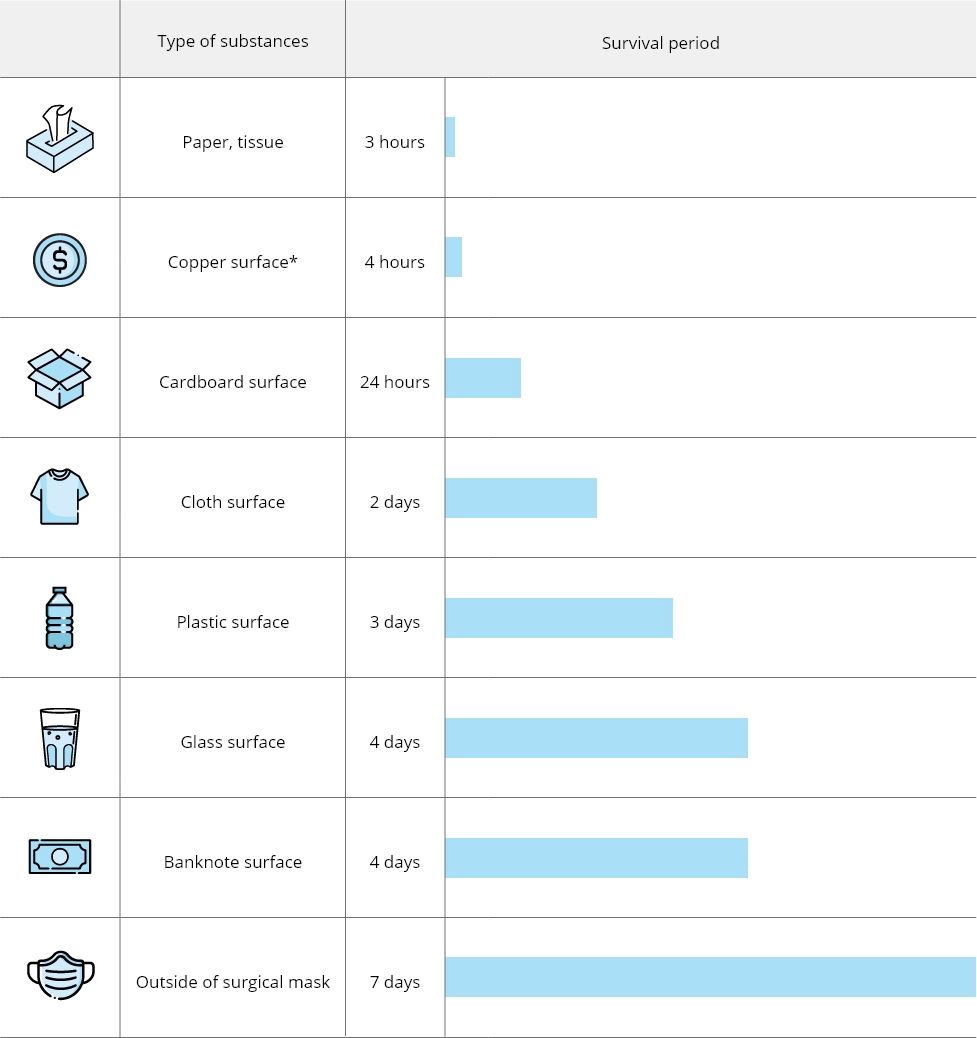
*Copper naturally degrades certain bacteria and viruses.
Survival period differs depending on surface irregularities.
Viruses survive longer on smooth surfaces than on irregular surfaces.
Source: https://www.businessinsider.com/coronavirus-lifespan-on-surfaces-graphic-2020-3
Effects on certain bacteria & viruses
Airborne bacteria
Staphylococcus aureus1
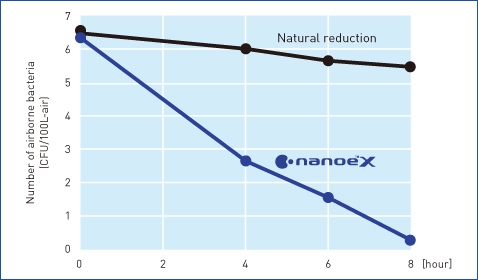
Airborne viruses
bacteriophageΦχ1744

Adhered bacteria
O1572
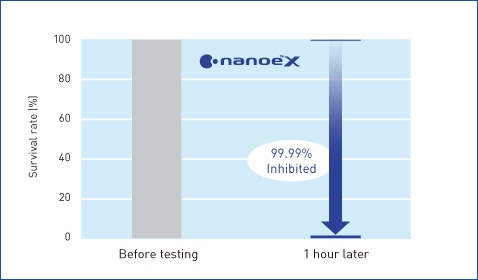
Adhered viruses
Influenza virus H1N1 subtype5
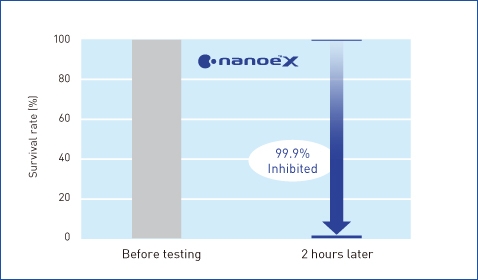
MRSA3

Poliovirus type1 (Lsc-2ab)6
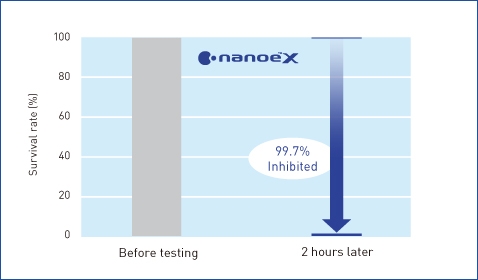
How nanoe™ X works

nanoe™ X reaches virus.

Hydroxyl radicals denature virus proteins.
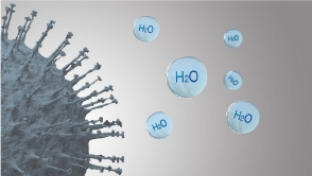
Virus activity is inhibited.1–6
1Airborne bacteria (Staphylococcus aureus). Testing organisation: Kitasato Research Center for Environmental Science. Testing method: The number of bacteria was measured after direct exposure in an approximately 25 m3-sized airtight test chamber. Inhibition method: nanoe™ released. Target substance: Airborne bacteria. Test result: Inhibited by at least 99.7% in 4 hours. (24_0301_1)
2Adhered bacteria (O157). Testing organisation: Japan Food Research Laboratories. Testing method: Measured the number of bacteria adhered to a cloth in an approximately 45 L-sized airtight test chamber. Inhibition method: nanoe™ released. Target substance: Adhered bacteria. Test result: Inhibited by at least 99.99% in 1 hour. (208120880_001)
3Adhered bacteria (MRSA). Testing organisation: Japan Food Research Laboratories. Testing method: Measured the number of bacteria adhered to a cloth in an approximately 45-L-sized airtight test chamber. Inhibition method: nanoe™ released. Target substance: Adhered bacteria. Test result: Inhibited by at least 99.99% in 1 hour. (208120880_002)
4Airborne viruses (bacteriophageΦχ174). Testing organisation: Kitasato Research Center for Environmental Science. Testing method: The number of viruses was measured after direct exposure in an approximately 25 m3-sized airtight test chamber. Inhibition method: nanoe™ released. Target substance: Airborne viruses. Test result: Inhibited by at least 99.7% in 6 hours. (24_0300_1)
5Adhered virus (Influenza virus H1N1 subtype). Testing organisation: Kitasato Research Center for Environmental Science. Testing method: Measured the number of viruses adhered to a cloth in an approximately 1 m3-sized airtight test chamber. Inhibition method: nanoe™ released. Target substance: Adhered viruses. Test result: Inhibited by at least 99.9% in 2 hours. (21_0084_1)
6Adhered viruses (Poliovirus type1(Lsc-2ab)). Testing organisation: Kitasato Research Center for Environmental Science. Testing method: Measured the number of viruses adhered to a cloth in an approximately 45 L-sized airtight test chamber. Inhibition method: nanoe™ released. Target substance: Adhered viruses. Test result: Inhibited by at least 99.7% in 2 hours. (22_0096)
Results may vary based on usage and seasonal and environmental variables (temperature and humidity). nanoe™ X and nanoe™ inhibit activity or growth of pollutants, but do not prevent illness.
Evidence
Viruses
nanoe™
nanoe™ X
nanoe™ X (nanoe™ X Generator Mark 2)
| Target | Results*¹ | Test space | Exposure time (hr) | Testing organisation | Report No. | ||
|---|---|---|---|---|---|---|---|
| Adhering | Enterovirus (EV71) | 99.9% | 30 m³ | 4 | China Electronic Product Reliability and Environmental Testing Research Institute | J2002WT8888-00439 | |
Enterovirus (EV71) | 99.9% | 30 m³ | 6 | China Electronic Product Reliability and Environmental Testing Research Institute | J2002WT8888-00439 | ||
Enterovirus (EV71) | 97.6% | 30 m³ | 4 | China Electronic Product Reliability and Environmental Testing Research Institute | J1911WT8888-04860-01 | ||
Enterovirus (EV71) | 99.9% | 30 m³ | 6 | China Electronic Product Reliability and Environmental Testing Research Institute | J2003WT8888-00453 | ||
Coxsackie virus (CA16) | 99.9% | 30 m³ | 4 | China Electronic Product Reliability and Environmental Testing Research Institute | J2002WT8888-00439 | ||
Coxsackie virus (CA16) | 99.9% | 30 m³ | 6 | China Electronic Product Reliability and Environmental Testing Research Institute | J2002WT8888-00439 | ||
Coxsackie virus (CA16) | 95.4% | 30 m³ | 4 | China Electronic Product Reliability and Environmental Testing Research Institute | J1911WT8888-004860-02 | ||
Coxsackie virus (CA16) | 99.9% | 30 m³ | 6 | China Electronic Product Reliability and Environmental Testing Research Institute | J2003WT8888-00453 | ||
Coronavirus (HCoV-229E) | 99.9% | 30 m³ | 4 | China Electronic Product Reliability and Environmental Testing Research Institute | J2002WT8888-00544-01 | ||
Coronavirus (HCoV-229E) | 99.9% | 30 m³ | 4 | China Electronic Product Reliability and Environmental Testing Research Institute | J2003WT8888-00889 | ||
Herpes simplex virus | 99.9% | 30 m³ | 4 | China Electronic Product Reliability and Environmental Testing Research Institute | J2003WT8888-00889 | ||
| Airborne | Enterovirus (EV71) | 95.4% | 30 m³ | 1.5 | China Electronic Product Reliability and Environmental Testing Research Institute | J2002WT8888-00439 | |
Enterovirus (EV71) | 96.9% | 30 m³ | 1.5 | China Electronic Product Reliability and Environmental Testing Research Institute | J2003WT8888-00889 | ||
Influenza virus (H1N1) | 95.4% | 30 m³ | 1.5 | China Electronic Product Reliability and Environmental Testing Research Institute | J2002WT8888-00439 | ||
Influenza virus (H1N1) | 98.3% | 30 m³ | 1.5 | China Electronic Product Reliability and Environmental Testing Research Institute | J2003WT8888-00889 |
nanoe™ X (nanoe™ X Generator Mark 3)
| Target | Results*¹ | Test space | Exposure time (hr) | Testing organisation | Report No. | ||
|---|---|---|---|---|---|---|---|
| Adhering | Bacteriophage | Inhibited 98.81% | Approx. 139.3m³ | 4 | SGS Inc | SHES210901902584 | |
MS2 Phage Virus | Inhibited 99.99% | Approx. 25m³ | 2 | Shokukanken, Inc. | 227131N | ||
| Escherichia coli phage | Inhibited 99% | Approx. 30m³ | 8 | Kitasato Research Center for Environmental Science | 2022_0292 | ||
| Airborne | Escherichia coli phage | Inhibited 99% | Approx. 30m³ | 6 | Kitasato Research Center for Environmental Science | 2022_0238 |
Bacteria
nanoe™
| Target | Results*¹ | Test space | Exposure time (hr) | Testing organisation | Report No. | ||
|---|---|---|---|---|---|---|---|
| Adhering | Enterohemorrhagic Escherichia coli | 99.99% | 45 L | 1 | Japan Food Research Laboratories | 208120880-001 | |
99.9% | 45 L | 2 | Eurofins | 2010/456-3 | |||
Enterohemorrhagic | 99.99% | 45 L | 2 | 2010/456-4 | |||
Methicillin-resistant Staphylococcus aureus | 99.99% | 45 L | 1 | Japan Food Research Laboratories | 208120880-002 | ||
99.99% | 45 L | 1 | Eurofins | 2010/456-1 | |||
99.9% | 45 L | 2 | Osaka Prefecture University | ||||
Escherichia coli | 99.9% | 45 L | 1 | Panasonic Product Analysis Center | E02-080303IN-01 | ||
Staphylococcus aureus | 99.99% | 1,000 L | 0.34 | Kitasato Research Center | 20_0154_2 | ||
99.2% | 10,000 L | 24 | Panasonic Product Analysis Center | E02-090701IN-01 | |||
99% | 10,000 L | 24 | Japan Food Research Laboratories | 209071031-001 | |||
99.1% | Approx. | 8 | 13044083003-01 | ||||
99% | Approx. | 8 | SGS | SHES160600431171 | |||
Multiple-drug-resistant Pseudomonas aeruginosa | 99% | 45 L | 2 | Toho University Faculty of Medicine, | |||
Multi-drug resistant Acinetobacter baumannii | 99% | 45 L | 2 | ||||
Bacillus | 99.7% | 45 L | 0.5 | Japan Food Research Laboratories | 11000924001-01 | ||
Micrococcus | 99.9% | 45 L | 2 | 11000924001-02 | |||
Serratia | 99.9% | 45 L | 2 | 11000924001-03 | |||
Kocuria | 99.9% | 45 L | 1 | 11000922001-01 | |||
methicillin-resistant staphylococcus pseudintermedius | 99.5% | 45 L | 2 | Nippon Medical School, | |||
Bordetella bronchiseptica | 99.9% | 45 L | 2 | ||||
Pasteurella multocida | 99.9% | 45 L | 1 | ||||
Listeria monocytogenes | 99.9% | 45 L | 2 | Osaka Prefecture University | |||
Bacillus subtilis | 99.9% | 45 L | 4 | ||||
Mycobacterium smegmatis | 99.9% | 45 L | 4 | ||||
Nocardia asteroids | 99.9% | 45 L | 4 | ||||
Neisseria gonorrhoeae | 99.9% | 45 L | 1 | ||||
Salmonella enterica subsp. enterica | 99.9% | 45 L | 2 | ||||
Haemophilus influenza | 99.9% | 45 L | 1 | ||||
Campylobacter jejuni | 99.9% | 45 L | 4 | ||||
| Airborne | Staphylococcus aureus | 99.9% | 1,000 L | 0.34 | Kitasato Research Center | 20_0154_1 | |
99% | 10,000 L | 4 | 21_0142 | ||||
99.9% | 10,000 L | 3 | 21_0044 | ||||
99.7% | Approx. | 4 | 24_0301_1 |
nanoe™ X
| Target | Results*¹ | Test space | Exposure time (hr) | Testing organisation | Report No. | ||
|---|---|---|---|---|---|---|---|
| Adhering | Enterohemorrhagic Escherichia coli | 99.99% | 45 L | 1 | Japan Food Research Laboratories | 208120880-001 | |
99.9% | 45 L | 2 | Eurofins | 2010/456-3 | |||
Enterohemorrhagic | 99.99% | 45 L | 2 | 2010/456-4 | |||
Methicillin-resistant Staphylococcus aureus | 99.99% | 45 L | 1 | Japan Food Research Laboratories | 208120880-002 | ||
99.99% | 45 L | 1 | Eurofins | 2010/456-1 | |||
99.9% | 45 L | 2 | Osaka Prefecture University | ||||
Escherichia coli | 99.9% | 45 L | 1 | Panasonic Product Analysis Center | E02-080303IN-01 | ||
Staphylococcus aureus | 99.99% | 1,000 L | 0.34 | Kitasato Research Center | 20_0154_2 | ||
99.2% | 10,000 L | 24 | Panasonic Product Analysis Center | E02-090701IN-01 | |||
99% | 10,000 L | 24 | Japan Food Research Laboratories | 209071031-001 | |||
99.1% | Approx. | 8 | 13044083003-01 | ||||
99% | Approx. | 8 | SGS | SHES160600431171 | |||
99.91% | 24 m³ | 8 | Panasonic Product Analysis Center | 1V332-170703-F04 | |||
Multiple-drug-resistant Pseudomonas aeruginosa | 99% | 45 L | 2 | Toho University Faculty of Medicine, | |||
Multi-drug resistant Acinetobacter baumannii | 99% | 45 L | 2 | ||||
Bacillus | 99.7% | 45 L | 0.5 | Japan Food Research Laboratories | 11000924001-01 | ||
Micrococcus | 99.9% | 45 L | 2 | 11000924001-02 | |||
Serratia | 99.9% | 45 L | 2 | 11000924001-03 | |||
Kocuria | 99.9% | 45 L | 1 | 11000922001-01 | |||
methicillin-resistant staphylococcus pseudintermedius | 99.5% | 45 L | 2 | Nippon Medical School, | |||
Bordetella bronchiseptica | 99.9% | 45 L | 2 | ||||
Pasteurella multocida | 99.9% | 45 L | 1 | ||||
Listeria monocytogenes | 99.9% | 45 L | 2 | Osaka Prefecture University | |||
Bacillus subtilis | 99.9% | 45 L | 4 | ||||
Mycobacterium smegmatis | 99.9% | 45 L | 4 | ||||
Nocardia asteroids | 99.9% | 45 L | 4 | ||||
Neisseria gonorrhoeae | 99.9% | 45 L | 1 | ||||
Salmonella enterica subsp. enterica | 99.9% | 45 L | 2 | ||||
Haemophilus influenza | 99.9% | 45 L | 1 | ||||
Campylobacter jejuni | 99.9% | 45 L | 4 | ||||
| Airborne | Staphylococcus aureus | 99.9% | 1,000 L | 0.34 | Kitasato Research Center | 20_0154_1 | |
99% | 10,000 L | 4 | 21_0142 | ||||
99.9% | 10,000 L | 3 | 21_0044 | ||||
99.7% | Approx. | 4 | 24_0301_1 |
nanoe™ X (nanoe X Generator Mark 3)
| Target | Results*¹ | Test space | Exposure time (hr) | Testing organisation | Report No. | ||
|---|---|---|---|---|---|---|---|
| Adhering | Staphylococcus Aureus | Inhibited 99% | Approx. 30m³ | 12 | Kitasato Research Center for Environmental Science | 2022_1292 | |
| Airborne | Staphylococcus Aureus | Inhibited 99% | Approx. 30m³ | 5 | Kitasato Research Center for Environmental Science | 2022_0237 |











